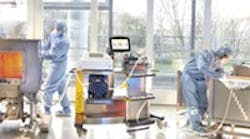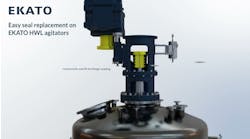MICROBIAL PRODUCTION
Figure 3. Unit reportedly is the first fully instrumented single-use bioreactor designed specifically for microbial applications. Source: Eppendorf.
The rigid-wall bioreactor features working volumes of 65–250 mL and includes two Rushton impellers that achieve oxygen intake levels comparable to industrial glass and stainless-steel units. All critical parameters, such as temperature, pH and dissolved oxygen, can be monitored and regulated using industry-standard sensors."We're pleased to be taking a new direction in single-use bioreactor technologies," explains Matthias Arnold, managing director of DASGIP Information and Process Technology, which became part of Eppendorf last year. "The physical requirements placed on single-use systems for microbial applications are much higher than the demands that are placed on cell culture processes — the conventional field of application for disposable bioreactors. By working together with the polymer experts at Eppendorf, we managed to overcome these hurdles, and as a result were able to optimally match material, design and functionality at the highest level of quality."Meanwhile, Thermo Scientific, Waltham, Mass., has introduced technology to improve cell culture performance in its HyPerforma single-use bioreactors. Cell growth depends upon the availability of the right amount of oxygen in the bioprocess, which in turn hinges on sparging of air to create the optimal environment. Its new dual-sparger design consists of a micro- and a macro-sparger and is engineered to produce a consistent bubble size for predictable scaleup and performance from the company's 50-L to 2,000-L single-use bioreactors. The micro-sparger features a porous frit design that produces bubble sizes in the range of 20–40µm diameter, creating a higher surface area and better oxygen transfer. The new macro-sparger, known as a drilled hole sparger (DHS), is a film-based sparging disc with laser-drilled pores — the specific size and quantity of the pores is tailored for each single-use bioreactor volume. The larger air bubbles of the DHS support the micro-sparger with oxygen transfer and improve the removal of carbon dioxide."This next-generation design sets a new standard of performance, flexibility and ease of use during scaleup for all cell culture applications," claims Millie Ullah, senior product manager for single-use systems.Applikon Biotechnology, Tewkesbury, U.K., has launched micro-Matrix, which it describes as the next generation in micro-bioreactors. Containing 24 independent bioreactors in a simple microtiter plate footprint, micro-Matrix affords separate control — e.g., of pH, temperature, dissolved oxygen, individual liquid additions and up to four separate gas additions — of each bioreactor. Users can implement advanced strategies such as cascade controls (up to five actuators per process variable), time-based setpoint changes, and event-triggered liquid feeds. Liquid feeding can occur via a variety of addition profiles, too.The micro-Matrix's software offers an easy way to operate 24 bioreactors in parallel, plus simple comparisons of large numbers of experimental cultures, says the company. Using an instinctive left-to-right progression, the interface guides operators through experimental setup, instrument configuration, control strategy definition and data visualization. All data can be exported from the instrument during or after the experiment.
NEW WEBSITE FOCUSES ON SINGLE-USE-SYSTEM DOCUMENTSThe AdvantaPure division of NewAge Industries, Southampton, Pa., has launched
SUSdocs.org, a searchable directory of online documents related to single use systems (SUS) in the pharmaceutical, biopharmaceutical, and bioprocess industries. A number of organizations — BPSA (BioProcess Systems Alliance), ASME-BPE (American Society of Mechanical Engineers-Bioprocessing Equipment), PDA (Parenteral Drug Association), ASTM International and ISPE (International Society of Pharmaceutical Engineers) — provide information for the website.SUSdocs.org was developed following a summer industry meeting on single-use systems where attendees, including many from associations and equipment manufacturing companies, commented that having data regarding single-use systems in one place would be helpful. Examples of documents and articles found on SUSdocs.org include: "BPSA Extractables and Leachables Guide," "Designing the Ideal Bioreactor with Single-Use Technology," "PDA Technical Report No. 22 (Revised 2011), Process Simulation for Aseptically Filled Products" and "The Maturation of Single-Use Applications."






